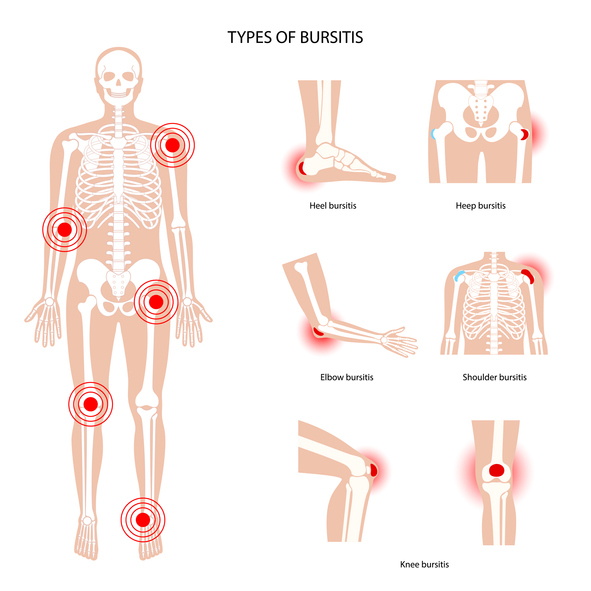Bursitis may not be as commonly known as arthritis, but it is just as difficult and debilitating to live with. This condition is similar to arthritis in that it causes joint inflammation. However, bursitis is caused by inflammation of the bursae, which are small fluid-filled sacs that help keep the joints lubricated and allow for smooth motion. The resulting symptoms of pain swelling and stiffness can have a highly negative effect on the quality of life and ability to accomplish daily activities.
As a joint injury, bursitis can develop at different locations throughout the body, but there are five major locations where it most commonly develops. Whether you have been recently diagnosed with bursitis or are looking into potential causes of your pain, we hope the following guide can help you be more engaged with your treatment.
The BEST Health System team is here to help and we invite you to reach out at any time to learn more.
What Causes Different Types Of Bursitis
Like many medical conditions and injuries, the risk of bursitis increases as we get older. In general, bursitis is a repetitive motion injury that occurs due to excessive pressure on the joint. This can be due to engaging in physical activities such as bending and stooping, having improper posture, or working a physical job.
Bursitis can also develop in conjunction with arthritis, if the joint inflammation puts pressure on the bursae in the joints, or irritates them. Patients dealing with pain and swelling in a joint for an extended period of time should seek out medical advice and diagnosis from a qualified physician.
As a repetitive motion injury that is caused by stress to the joints, types of bursitis are generally classified by location. The most common joints for bursitis to develop are in the following locations:
1. Bursitis Of The Elbow
Elbow bursitis is caused by the inflammation of the bursa between the soft tissue and the elbow bones. Bursitis of the elbow can be caused by trauma, prolonged pressure, or a related medical condition such as osteoarthritis, rheumatoid arthritis, or gout. The most common symptoms include pain and swelling.
2. Bursitis Of The Knee
The knee joint has bursae in multiple locations, including the upper knee, lower knee, and the kneecap itself. Any one of these bursae can become irritated or inflamed, resulting in bursitis, although the kneecap and inner knee are commonly reported locations.
The most common causes of knee bursitis include kneeling on hard surfaces for prolonged periods of time, so it is common among carpenters and plumbers. Additionally, repetitive motions or excessive force can cause this injury, resulting in the telltale symptoms of stiffness, pain, and swelling.
3. Bursitis Of The Hip
Hip bursitis is a very frequently reported form of this condition due to the tremendous stress we put on our hip joints, including the bursae. Like other types of bursitis, hip bursitis is primarily an overuse injury, but it can also be caused by factors like a previous hip injury and a leg length imbalance that causes uneven pressure on the hips. Additionally, hip issues such as calcium deposits and bone spurs can also put pressure on and irritate the bursae in the hips.
Patients experiencing mobility problems, pain, and stiffness should seek medical advice from their doctor to receive a proper diagnosis.
4. Bursitis Of The Heel
The back of the heel in the foot contains a bursa sac that is particularly prone to swelling and inflammation. Although it is a distinct injury, bursitis of the heel is often related to Achilles tendinitis due to the proximity of the bursae to this tendon. If the Achilles tendon becomes inflamed or injured it can also irritate the bursae in the heel, resulting in bursitis.
Some of the most common risk factors include not stretching before workouts or strenuous activities or suddenly increasing the frequency and intensity of exercise.
5. Bursitis Of The Shoulder
Another common location for bursitis to develop is in the shoulder joints. Like other locations, bursitis of the shoulder is associated with trauma, overuse, and complications related to different forms of arthritis. This includes the development of bone spurs.
Shoulder bursitis can often result in a reduced range of motion as well as pain and swelling in the shoulder. This injury often develops in athletes including golfers and swimmers, as well as carpenters, musicians, and gardeners due to the strain these activities can place on the shoulder joints.
Treatment Options For Bursitis
In very many cases, bursitis is a medical condition that can be successfully treated without the need for surgery. The standard medical advice upon diagnosis is to recommend a course of conservative therapies that include rest, over-the-counter anti-inflammatory medication, and physical therapy. It is also important to make any necessary lifestyle changes such as improving posture, modifying activities, and eating an anti-inflammatory diet.
Doctors may also recommend therapeutic injections consisting of a corticosteroid to relieve inflammation of the bursae. This can help patients complete physical therapy and maintain activity levels while physicians and patients monitor the overall progress of the condition.
Surgery is generally seen as a last resort treatment option, but if pain and swelling persist despite fully exploring conservative treatments, your doctor may recommend it. The surgical approach will vary according to the location and severity of bursitis but it is possible to perform bursitis surgery on an outpatient basis thanks to the continued development of new surgical techniques.
BEST Health System Can Help Patients!
If you’re living with bursitis and seeking relief, the caring and experienced team at BEST Health System can help at any stage of the treatment. From physical therapy to minimally invasive surgery, we provide individualized and effective medical treatment that matches your lifestyle and care goals. Bursitis doesn’t have to negatively affect your life and relationships, start your journey toward relief today.
